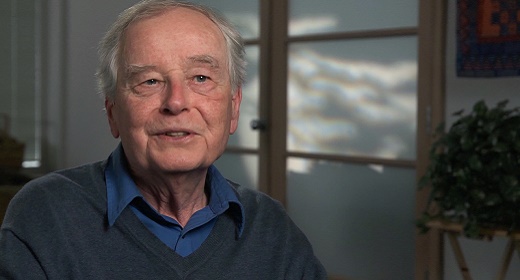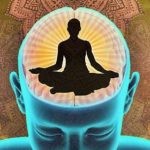The following is excerpted from Words at the Threshold by Lisa Smartt, published by New World Library…

So imagine for a moment: What kind of language might you use to describe the experience of dying?
Not only is it an experience for which the listener has no compelling reference point, but also it is completely strange and new to the person who is dying. It is, in every way, completely without a frame of reference for most of us. Consider, as well, both the possibility that dying is an incomprehensible this, as my father described it to his secretary a few days before dying (“This is very interesting, Alice”), and the possibility that if there is another dimension or an afterlife, it too would elude all the literal meanings we have known in this world. Perhaps just by crossing into these new dimensions, we engage new parts of our brains and, as a result, our language.
Those who have had near-death experiences say it is impossible to find the words to explain their experience. Their experience is ineffable.
When we look at the continuum of language from literal to nonsensical, something fascinating emerges: These different kinds of language are associated with different parts of the brain, according to recent brain-scan research. Literal language, the kind you use to describe a chair, engages regions in the left hemisphere, which have traditionally been associated with the language of literal, shared reality. But figurative language, such as the simile “My love is like a red, red rose,” engages both the left and right hemispheres in the brain. In an article published in Scientific American the author explains, “Previous brain-imaging research has shown that interpreting metaphors requires a variety of areas on both sides of the brain, compared with literal language, which is processed in known language areas in the left hemisphere.” However, a nonsense sentence, such as “My love is thorning the spiraling plotz,” engages the right hemisphere’s regions associated with mystical experiences and music, as we will see later in much greater detail.
Is it possible, then, that as we approach death we have experiences that are more difficult to express with the usual range of language, so there is an increase in metaphoric and puzzling constructions? Or is it that as we die, regions of the left hemisphere associated with literal, sensory language become degraded? And that, as a result, there is greater reliance on language that involves right-hemispheric functions in those days before death? Or are both ideas true? Are we wired to have experiences at the end of life that fall outside of literal language, and do these experiences have the effect of somehow arresting or interfering with our left-hemispheric functions, so that degradation of the literal-language functions leads to more symbolic and non-sense-ical experiences?
Raymond Moody suggests that when “the mind shifts from an intelligible dimension to a less comprehensible dimension, it generates nonsense; a literal account would just be wrong. The mind is forced to talk nonsense transitioning between dimensions.” Moody uses the word nonsense to refer to language that does not make literal sense to those who hear it. However, he also indicates that almost every language is unintelligible “nonsense” to those who do not know the language and its spoken and written linguistic patterns: for example, Chinese is nonsense to those who do not speak it. As we learn more about the continuum of language that appears in our final days, it becomes increasingly meaningful to us and sounds less like nonsense.
The Language of the Near-Death Experience
Raymond Moody’s understanding of the unique properties of unintelligible language was, in part, what led him to coin the term near-death experience. Before becoming a medical doctor, he earned a doctorate in philosophy and focused much of his graduate study on unintelligibility and nonsense. When he began to hear unusual stories from patients who had died and were then revived, he became intrigued.
The stories he heard from his patients followed patterns very similar to those of nonsense stories he had studied as a philosophy student. Much like the characters in Alice in Wonderland, his patients were saying things that seemed to challenge the usual notions of space and time; and like Lewis Carroll’s characters, Moody’s patients often spoke in puzzling paradoxes. Some of the things he heard from patients who had died and come back to life were sentences like these:
“There was time, but no time.”
“I felt more alive when I was dead than when I was living.”
“I understood everything everyone said, but not a word was spoken.”
“I left my body and traveled through the galaxies, all while I was lying motionless in bed.”
“It felt like it took a minute, but it also felt like a thousand years.”
All of these sentences are paradoxical. How is it possible that something felt like a journey through the galaxies when, indeed, the patient lay motionless in bed, or felt like a minute but also a thousand years? These were intriguing statements, and as he heard paradoxical descriptions from his patients, he became increasingly curious about them. How could it be that a patient who came back to life reported never feeling as alive as when he was dead?
Over the course of years, as Moody wrote down accounts of these changes in the language and experiences of his patients, a pattern emerged that he identified as the near-death experience. Through his patients’ “nonsensical stories,” he pinpointed a unique set of experiences shared by some who had died and come back to life. Moody was particularly drawn to their narratives because their stories clearly described some kind of journey even though there had actually been no real movement from point A to point B, as we understand motion in three-dimensional reality. The stories that emerged were technically nonsense travel narratives. That is, in terms of the literal reality we know, the stories were nonsensical. The “journeys” these patients described having taken during their near-death experiences violate almost everything we know about our three-dimensional and five-sense world.
A closer look at these patterns of language associated with near-death experiences reveals a foundation for understanding the language of dying.
The Nonsense Travel Narrative
Those who have had near-death experiences often describe a kind of journey that occurs outside of their physical bodies, and their descriptions involve one or all of the following: (a) moving up and out of one’s body, (b) moving through tunnels or valleys, and (c) meeting with deceased relatives or friends or spiritual figures and having a life review.
One of the features of a near-death experience (NDE) is that the person “moves up and out of the body” and has an “out-of-body experience”; this appears to be true whether a person reports a positive or a distressing NDE. The following description comes from John, one of the people I interviewed. He had a near-death experience after being taken to the hospital following a near-fatal car accident. His description is typical of the language people use as they speak about their out-of-body experiences: “The next thing I was aware of was floating on the ceiling of the hospital room. I could see everything that was going on below me — and even noticed the chalky white color of the ceiling.” Within the context of our understanding of this three-dimensional, five-sense world, his description is nonsense, since in our literal world people do not float out of their bodies or have the ability to closely examine the ceiling paint while they are motionless on a bed below. However, those who describe their out-of-body experiences will tell you that although the language may seem nonsensical, the experience is intelligible and meaningful to them. “While those below were having conversations about my being dead, I felt completely alive and conscious,” John explained.
Here is another representative description, from Lisa, who had a near-death experience after a heart attack: “I could feel I was leaving my body, and I could see down below. I don’t know how long I was up there. But then suddenly, it was like a hand came down to hold me; and that hand became the most incredible light as I lifted up.”
Those who describe out-of-body experiences explain they felt a strong sense of self at that moment, as if they were fully conscious, even though those in the physical world could not hear them or see or feel their movements above their lifeless bodies.
Movements up and out of the body are strongly associated with near-death experiences. We will see in later chapters that the very description of moving upward while physically motionless is also characteristic of the language of the dying.
Another common landmark in the travel narrative of those who have had near-death experiences is a tunnel or valley of some kind. This description comes from Sandi, who sent an email to the Final Words Project describing her NDE this way: “The tunnel I am in seems soft and long as if I am moving through a tunnel of clouds. I am ecstatic to be free and able to move with such grace and agility — to move so quickly. I am unburdened, unrestricted. Finally, I am myself again. As I go through the tunnel, I am moving toward the most beautiful golden light. I am home.”
Even when told in past tense, these accounts convey motion, a powerful counterpoint to the reality of the individuals’ lifeless bodies. This is clear in the testimony by Rick, who described his near-death experience that occurred after he was admitted to the hospital for sepsis. “I had the feeling I was moving through a very deep, dim valley. But I felt no fear. I actually felt comfort.”
Guides for the Journey
Those who share their near-death experiences often speak of encounters with family members and friends who had died before them, and who greeted them or guided them in their journey. They also speak of spiritual figures, or “beings of light.” Rick, for example, stated, “All these people were there. Many of them I had known and recognized, including a friend I knew back in elementary school. I felt their presence, and with some of them, I actually saw their bodies. I felt they all were welcoming me and wanted to protect or guide me.”
Lisa explained further about her experience of a hand that lifted her up after her heart attack: “This Divine Presence was all light. And that light seemed to speak to me, to tell me he would be guiding me now. I trusted that presence completely.”
On Christmas Day 1993, Shawna Ristic was in a serious car accident that pushed her near death and left her in a coma for many days. “I had a choice to come back or not,” she said, “and this decision was a joint decision between myself and the council, a group of twelve beings I met during my time on the other side. I learned that I am working with and representing them here on earth. I saw the ramifications of both choices, the peace of staying with the beings full of light and love that had lovingly lifted me from my body.”
References to “beings of light,” deceased friends and relatives, and other guiding figures appear not only in the descriptions of those who have had near-death experiences but also, as we will see, in the accounts recorded by the Final Words Project.
The Journey Culminates in Life Review
Many who have had a near-death experience explain that the journey out of their body, guided by spiritual figures, friends, or family, led them to a life review. This review covers the complete span of the person’s life and is often seen from the point of view of someone she or he had harmed.
Metaphoric language frequently appears in descriptions of these life reviews. In fact, those who recount their experiences say there is no way to explain the review process without resorting to analogies and symbols of this “afterlife” process. The metaphoric descriptions that I heard ranged from “It was like watching a movie” to “There were posts on rolling hills, and each post held an important landmark of my life; and it then came to life” to “It was as if there were globes, or spheres, like bubbles, that held images from my life.”
The near-death experience itself is often described as a story or journey and shares the same landmarks: moving up, looking down and perceiving the deathbed scenes below, traveling through a tunnel, meeting with predeceased friends or family or spiritual figures, and then traveling to or through a life review and “arriving back” at the body.
When we look closely at the language of these exceptional experiences, we see a clear evolution away from literal language to language that is both rich in metaphor and paradoxical or nonsensical. The accounts associated with near-death experiences have many of the critical markers that also exist in the language of the dying. We hear a travel story, a journey filled with symbolic and paradoxical statements and which offers the possibility of traveling to or through another state of being or dimension where the rules of our literal three-dimensional, five-sense world no longer exist. The language we hear is often non-sense-ical — not grounded in the senses as we know them — and promotes a whole new under-
standing








































